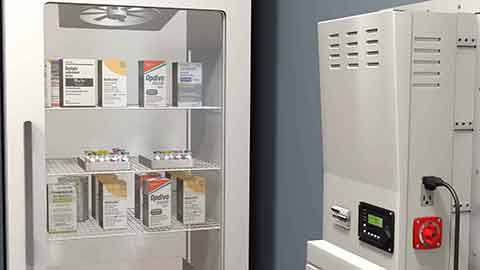How to Prepare Healthcare Facilities For 2022 Summer Blackouts
Recently researchers from the North American Electric Reliability Corporation (NERC) released a detailed report that vast swaths of the United States and Canada are at high-risk for mass blackouts in the coming summer months— the primary areas of risk being both the Great Lakes region as well as the West Coast.
While the exact reasons for the potential blackouts range from climate change to shuttered power plants and supply chain woes leftover from the COVID-19 pandemic, the claim from the report is that these regions are at an elevated risk of blackouts in even normal peak operating conditions. This means should they see any elevated demand for energy throughout the summer, the result could be catastrophic.
For those in charge of maintaining the safety of both inventory and patients in a medical facility, the increased potential for blackouts and power outages presents a unique challenge as the stability of the larger power grid is wholly out of their hands—though making sure your facility is prepared is the one element that you can control.
The need throughout both medical and laboratory facilities for reliable power remains critical, as patients directly (in a procedure room) and indirectly (bio medical cold storage) depend on this equipment for life, health, and wellness. Thus, no matter how brief, a power outage can have disastrous consequences for the average patient's life.
In light of this news, the elevated risks of blackouts this summer is understandably unwelcome. Thus, in order to both inform and prepare everyone across our industry as best as possible, the following will be a comprehensive look at both why we’re facing the possibility of rolling blackouts, the ripple effect it may have, and how best to mitigate the fallout.
What is Causing an Increased Number of Power Outages Across the United States?
As we have discussed in previous blog posts, according to the US Energy Information Administration (EIA), since 2013 the average time per year a typical customer in the United States experiences a power outage has more than doubled, from just over 3 hours per person, per year, to over 8 hours per person, per year—with almost the entire increase being attributable to the large increase in extreme weather events in the US.
By extension, NOAA predicts there is a 65 percent chance the US experiences an “above normal” number of hurricanes and tropical storms in summer 2022. Conversely, by the same study, there exists only a 25 percent chance of a “normal” year and 10 percent chance of a “below-normal” year.
The expected result is that facilities managers and hospital administrators should begin preparations now for an almost-certain increase in power outage time this year, continuing the trend of an ever growing unreliable power grid across the country.
Additional Major Causes of Power Outages in 2022
- Heat
- Drought
- Shuttered power plants
- Cyber-attacks
Climate change induced Heat Waves
As a result of climate change, the normal patterns and ways in which we experience seasons are changing rapidly—and not just via the aforementioned increase in extreme weather events. With summer temperatures reaching an all-time high, people end up utilizing more electricity to keep themselves cool via air conditioning units in order to both remain comfortable, but also to reduce their exposure to heat-related illnesses such as heatstroke.
The resulting increased demand puts more strain on the electric grid, and the extreme heat leads to increased chances of mechanical failure for conventional power plants. This reason is among the core contributors to the expected power shortfalls that are projected to plague the Midwest and West Coast this summer.
Were AC units the only strain on the grid, perhaps the increased demand for power and electricity would be more manageable. But unfortunately, other factors are placing additional strain on the grid such as:
Increased Wildfires/Droughts
Another result of broad climate change and increased temperatures, for many Americans the threat of widespread drought is something they may need to start worrying about, if they do not need to already. Beyond mere drinking water, drought conditions also significantly reduce the amount of energy that can be produced. This is because, across much of the western US already plagued by droughts, there is less water available for already existing “green energy” hydroelectric power plants—like the Hoover Dam.
Additionally, the drought threatens power plants that run on coal, gas, or nuclear power. This is because these plants create heat and need water for cooling. Thus, with reduced water availability, the plants are running harder, and there is a risk of them breaking down more often. Or, in order to preserve the machinery and mitigate damage, they will need to operate at reduced capacity and not produce the amount of power necessitated by consumers.
Additionally, drought also increases the risk of a potentially heavy wildfire season in much of the West—which is already underway in New Mexico for example. These fires cause further damage to and often threaten the power transmission lines that deliver electricity across the country.
Finally, while much smaller in scope compared to the large scale problems that droughts and fires can impose on major sources of energy, in areas suffering from prolonged wildfires the resulting smoke can end up blocking out the sun, reducing the amount of electricity solar facilities can create—another blow to the green energy creation that could feasibly help to mitigate these problems.
Overall Decrease In Energy Supply
As the US continues to transition to renewable and sustainable non-fossil fuel-based energy sources the shuttering of legacy plants—like coal fired plants— continues. At their peak in 2011, coal plants produced over 317,000 megawatts of power—by year’s end 2020 that amount had decreased by almost a third to just under 217,000 megawatts and continues to trend downward.
Increased Threat of Cyber Security Attacks and A World at War
With the US supporting Ukraine in the Russia-Ukraine War, power grids face a growing threat of cyber-attacks from the Russian nation. As of the writing of this blog, the European Union had recently announced a blocking of almost 90% of Russian oil flowing into the region by the end of 2022.
In combination with the likely increase of energy prices across the globe as a result of the restricted supply, security experts warn that attacks like the one suffered to the colonial pipeline last summer, may become more frequent in the coming months.
How Will My Medical Facility/Laboratory be Affected? How Can I Prepare?
As a health care facility, you must be prepared for disruptions in your power supply as a power outage can result in disastrous consequences in the following areas:
Critical Equipment Failures
Loss of functionality in critical equipment is the most pressing and immediately apparent danger of a blackout. Essential equipment like ventilators, dialysis machines, and other machines need constant power to work correctly. The patients that rely on them also need them to live. Thus, a momentary interruption of the power supply can prove disastrous.
While a facility may be able to move patients to alternative sites, this may be risky, depending on how many people need immediate attention. In addition, the logistics of getting them to the alternative facility, ensuring that they get there safely and have room to receive the care they need, can be overwhelming.
Loss of vaccines, medications, and biomedical material.
Vaccines and some types of medications that need constant refrigeration also risk going bad or losing their potency if exposed to prolonged temperature excursions. Thus, in addition to dealing with patients that require immediate medical attention, facilities also must concern themselves with preventing temperature excursions in vaccines and medical supplies. In the event you are not prepared and suffer a total loss of materials, the costs can reach into the hundreds of thousands of dollars depending on what you are storing at any given time.
Increased Energy Costs
NERC, who provided the study linked at the beginning of this article, estimates that total energy costs may surpass 200 percent in some cases this season—not at all surprising given the cost of gasoline has almost doubled since 2020.
How to Mitigate the Effects of More Frequent Power Outages
As the power grid becomes increasingly unreliable, the very first step you can take is to ensure your own supply remains stable via a reliable backup power source. Because any one person or facility has very little control over geopolitics or their local electrical grid, the best hands are your own.
A battery powered system —in addition to shoring up your facility’s ability to operate in an outage situation— can also help to avoid the aforementioned rapidly rising prices the gasoline, natural gas and diesel fuel markets. These potential costs could make gas generators an unviable addition to your facility in both the short term and long term.
Additionally, because MediProduct’s battery backup systems utilize sealed lead acid batteries, they enjoy the benefits of long-term energy storage, meaning when they are not in use, you will not need to waste electricity (and therefore money) recharging them because of idle discharging. This trait among others makes them the ideal uninterruptible power supply for deployment in both inpatient and outpatient medical facilities as well as the larger health services sector.
This is in stark contrast to lithium-ion which is not suitable for long-term storage, and fossil fuels like the aforementioned gasoline or diesel—which can go bad after a short period of time and may need to be frequently replaced. An expensive proposition in a world of gas prices which continue to go up.
How Does a Battery Powered Backup Generator Provide My Hospital, Surgery Center or Laboratory The Electricity I Need?
Our battery backup power systems are line-interactive, meaning that while the utility company supply is on, the system stays in standby mode. While the system is in standby mode, the utility power keeps the batteries charged and transfers power to the unit.
When the battery powered generator senses a loss of utility power, it transfers over to the systems’ batteries. Once the utility power is restored, the system automatically recharges the batteries and feeds them back to the supporting unit.
We can customize and size our systems to meet your desired run-time and support the specific appliance that needs the support. In addition, this allows us to offer backup run-times for up to forty-eight hours.
While they may not be the solution to the core problems that are facing each and every one of us today, they certainly can provide a solution to your problems right now and give you the peace of mind to continue your work as usual, knowing you’re protected regardless of what the next major problem that arises may be.


